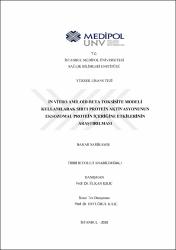| dc.contributor.advisor | Kılıç, Ülkan | |
| dc.contributor.advisor | Kılıç, Ertuğrul | |
| dc.contributor.author | Sarıkamış, Bahar | |
| dc.date.accessioned | 2021-09-29T05:19:14Z | |
| dc.date.available | 2021-09-29T05:19:14Z | |
| dc.date.issued | 2018 | en_US |
| dc.date.submitted | 2018-07-16 | |
| dc.identifier.citation | Sarıkamış, B. (2018). İn vitro amiloid-beta toksisite modeli kullanılarak sırt1 protein aktivasyonunun eksozomal protein içeriğine etkilerinin araştırılması. (Yayınlanmamış yüksek lisans tezi). İstanbul Medipol Üniversitesi Sağlık Bilimleri Enstitüsü, İstanbul. | en_US |
| dc.identifier.uri | https://hdl.handle.net/20.500.12511/8321 | |
| dc.description.abstract | Alzheimer hastalığı birincil olarak senil plaklar, nörofibriler yumak ve nörodejenerasyon ile karakterize edilir. Çalışmada SH-SY5Y insan nöroblastoma hattı kullanılarak Aβ toksisitesi oluşturulmuştur. Aβ toksisitesi oluşturulan hücrelerde NAD+ bağımlı deasetilazlardan sirtuin ailesinin yedi üyesinden biri olan in vivo ve in vitro olarak APP' nin amiloidojenik yolakta işlenmesini azalttığı bilinen SIRT1 aktivasyonunun, bir çok hücre tipi tarafından salgılanabilen ve vücut sıvılarında bulunabilen nano boyutlu eksozomların protein içeriğine etkisi ve SIRT1' in protein ekspresyonları üzerine etkisi incelenmiştir. Farklı varyasyonlarda gruplar oluşturularak hücre kültürü yapılan SH-SY5Y hücrelerine bir SIRT1 aktivatörü olan CAY10602 uygulanarak SIRT1 'in enzimatik aktivitesi etkinleştirilmiştir. Deney gruplarında eksozom salınımı belirlemek için eksozom yüzey belirteci olan Tsg101' in ekspresyonu incelenmiştir ve toksisite oluşturulmuş modellerde Tsg101' in arttığı görülmüştür. Ayrıca protein ekspresyonları incelenen AKT, PTEN, GSK3 ve mTOR seviyelerinde de SIRT1' in nöroprotektif etkileri görülmüştür. | en_US |
| dc.description.abstract | Alzheimer's disease is primarily characterized by neurofibrillary tangles, senile plaques, and neurodegeneration. In this study, Aβ toxicity was made using SH-SY5Y human neuroblastoma cell line. One of the seven members of the sirtuin family of NAD + -dependent deacetylases, which is known to reduce the processing of APP in the amyloidogenic pathway in vivo and in vitro named SIRT1 and its activation investigated to nano-sized exosomes that can be secreted by many cell types and found in body fluids and the effect of SIRT1 activation on protein expression was examined in Aβ toxicity-induced cells. Enzymatic activity of SIRT1 was activated by applying CAY10602 is a SIRT1 activator, to SH-SY5Y cells cultured in different variated groups. In the experiment groups, the expression of Tsg101, an exosomal surface marker, was examined to determine exosomal release, and Tsg101 was found to increase in the toxicity-induced models. In addition, SIRT1' neuroprotective effect was also observed for AKT, PTEN, GSK3 and mTOR in which protein expressions were examined. | en_US |
| dc.language.iso | tur | en_US |
| dc.publisher | İstanbul Medipol Üniversitesi Sağlık Bilimleri Enstitüsü | en_US |
| dc.rights | info:eu-repo/semantics/openAccess | en_US |
| dc.subject | Alzheimer | en_US |
| dc.subject | SIRT1 | en_US |
| dc.subject | Eksozom | en_US |
| dc.subject | SH-SY5Y | en_US |
| dc.subject | Alzheimer | en_US |
| dc.subject | SIRT1 | en_US |
| dc.subject | Exosome | en_US |
| dc.subject | SH-SY5Y | en_US |
| dc.title | İn vitro amiloid-beta toksisite modeli kullanılarak sırt1 protein aktivasyonunun eksozomal protein içeriğine etkilerinin araştırılması | en_US |
| dc.title.alternative | The investigation of the effects of activation sirt1 protein to the exosomes protein contents by using in vitro amyloid beta toxicity | en_US |
| dc.type | masterThesis | en_US |
| dc.department | İstanbul Medipol Üniversitesi, Sağlık Bilimleri Enstitüsü, Tıbbi Biyoloji Ana Bilim Dalı | en_US |
| dc.relation.publicationcategory | Tez | en_US |


















